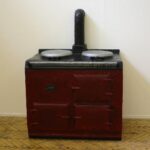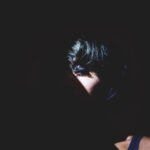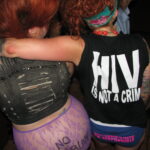Visual AIDS deeply values our international community of Artist+ Members and advocates for the dialogues they provoke around HIV/AIDS worldwide. This spring, Artist+ Member Clair Walton visited the Visual AIDS office from Stratford upon Avon in England, for the event WOMEN, ART, AIDS, ACTIVISM: HERE THEN, HERE NOW. We also welcomed our fourth annual Curatorial Resident, Ajamu from London, England, in March. Back home in England, Ajamu and Clair met this summer to discuss Clair's work and its relationship to questions of stigma and silence around women and HIV/AIDS.
Ajamu: Would you like to give a brief bio of yourself for those people who may not be aware of your practice?
Clair Walton: I mostly work with sculpture and more recently also reclaimed video footage. My work is around the fragility and the strength you find in adversity. It grows out of the secretness and silences many people with HIV find themselves in. My background is as a woman living with HIV, having been diagnosed in 1987, 30 years this coming year 2017. I come from a background and time of deep turmoil following the emergence of HIV in the 1980s.
As many others who witnessed and experienced that period - the horror and stigma which surrounded it, had a profound effect on me as a young woman. It is not to say it does not happen today, it does, but it was very much a sudden overwhelming climate of horror, fear, terror, discrimination and stigma for those pioneers; those infected and their lovers, their caretakers, their friends, their families – a ripple effect across communities.
My husband was diagnosed before me and subsequently died. That, silencing, silenced, silences, self-silences, and indeed that ultimate silence of death I felt I wanted to speak about in my work. In doing so the practice itself is an emergence from silence. I wanted to speak about the experience of living with HIV, not in an overt way, not in a sad way, but in a gentler way, perhaps to find meaning, or as an antidote. We can find life in adverse situations.
When I began, I never explicitly mentioned my work was related to HIV. Mainly due to the stigma and discrimination – particularly living in a small town. Much of the early images we saw relating to HIV/AIDS were of the horror, the physical destruction of the body – I just wanted to be away from that. I have been greatly influenced by the work of Felix Gonzales-Torres – who said he did not need to see an image of someone dying in a hospital bed to understand AIDS.
One of the works I have on the website is called Red Aga (2010). An Aga is a brand of cooker you have in your kitchen, it’s a very iconic piece, it is an aspirational addition to the household in certain communities – it is a status symbol. The domestic function of it is at the heart of the home was important to the work. I made the life size work out of polystyrene and beeswax, the smell of the beeswax again having the domestic wholesome goodness about it; it was very much influenced by Robert Gober wax pieces. When I made that work it was to reflect a group of people that was contaminated with blood products: a group of 1283 hemophiliacs and their partners in the UK, who, in my experience, have been silence (d).
I have worked with HIV organizations over the years in London. In 1999/2000 I worked for Positive Futures within an organization calls FACTS in Crouch End. It put me in touch with all the HIV organizations, which would have existed at the time: The Lighthouse, Body Positive, The Globe, Positively Women, Terrence Higgins Trust (THT) , UK Coalition, BlackLiners. I have always tried to look at the positive side of things, rather than the negative, preferring the quietness. Some might say a survival technique. I have found myself increasingly becoming a reluctant activist around the silencing and silences around the whole issue of contaminated blood in this country as I discover the extent of the cover up – silencing – of the subject. The Red Aga was reflecting the blood, but that silence was there.
Ajamu: How did you come into contact with Visual AIDS and what are some of the images in your Visual AIDS' Artist+ Member webpage online?
Clair Walton: I first came across Visual AIDS in 2015 when I began to research the legacy of women, HIV and art - I was sent a link for the call for applications to the Curatorial Residency. I donated a piece of work to Postcards from the Edge and a dialogue began then. Visual AIDS, and the wonderful support from the team, has since been a vital connection in my practice as I continue to research the work of women and what work they've produced since the emergence of HIV/AIDS.
Where are the women living with HIV/AIDS in contemporary art? I am interested to find out what exists now, what existed then. There are women that were silent, silenced, silence(d), by definition of being silent there are women who have not spoken, who have not produced art or if art has been created it is not out there. It is not public. Looking to the present, I am seeking to create opportunities to ‘hear’ those silent voices in one form or another.
There are iconic artworks that speak that are out there; undoubtedly the Art, AIDS, America exhibition showcases that. But there are voices of women who have not been able to speak. That is why the work of younger women such as Kia Labeija and Jessica Whitbread is so important. There is a lack of woman’s voices but of those that are out there, what is interesting is that sometimes they are saying the same things that were being said 30 years ago amongst women within the women's groups, the same issues in today’s art practices.
I have put some of my earlier pieces on my Artist + page on the Visual AIDS website, including the Red Aga (2010) and Dying West (2009). Dying West is a piece about strength. It was chosen for New Art West Midlands Arts in 2013 and exhibited at the Barber Institute in Birmingham as a contemporary work amongst the permanent collections. Again, at the time of its making I wanted the viewer to discover meaning for themselves, HIV was not mentioned, but it emerged in the conversations amongst the curious. It was about my strength, where I was coming from - my inherited strength. Dying West is a bicycle wrapped in wool. The bicycle belonged to my mother (born in 1927), who had emigrated from the West of Ireland to the England, where she married, raised seven children and rode her bicycle to and from work as a nurse until she retired in her sixties. The work reflected on a chapter ‘The Land and the People are One - Dying West’ in Jill and Leon Uris’s book Ireland: A Terrible Beauty. It describes a beauty of the landscape and the strength and gentle beauty of the people of the West of Ireland.
I am currently working with film and reclaimed video footage: having my voice heard through Parliament, over the last few years raising awareness on what happened to contaminated blood, not necessarily looking for answers but the way Parliament and the Government deal with the issue. Parliament and the democratic process is very interesting and I found that I was attending the House of Commons and particularly of interest was Westminster Hall where the audience in the debates is recorded, where I found myself. I found my words in reports I was contributing to being relayed in Parliament. I have been reclaiming the images and words spoken in parliament, that’s what I am working on now, its an on-going piece as the debate continues.
Ajamu: Let us jump back to some of your early work again. You have worked with books, archives, beeswax, wrapping—what this brings up for me are notions of tactility, materiality. You spoke about beauty, trying to present another kind of narrative in this area. Where do ideas of sensualness, pleasure come into your work?
Clair Walton: My profession has always been a caring profession. By the nature of the caring - I was trained as an archive and book conservator and spent many years – throughout my own diagnosis including death of my husband – in senior positions managing conservation departments with the responsibility for the care and treatment of material dating from the twelfth century to the present day. This included rare books, archive documents, parchment with wax seals, maps, photographs, glass plate negatives – in fact, any material deposited in an archive.
I cared and nurtured – there is a sensuous, tactility, sensitivity when handling historic material – an awareness of what went before - one of my main positions was when I set up and managed the conservation studio at The Shakespeare Birthplace Trust. I worked there for 12 years, this included caring for material of Shakespeare and his contemporaries, as well as material relating to Stratford upon Avon, and the surrounding area.
It has been my role to gently take without destroying, without harming, material from one generation to another - T S Elliot talks of ‘time future contained in time past’. It is the future contains in time past that I take from my work as a professional conservator into my life as a woman living with HIV and in my art practice. Every decision I had to make I had to think about the future, no matter what, whatever materials I was using in order to conserve, the conditions of the environment, where and how the archival material was stored had to be considered – every permutation so that I could make responsible and informed decisions on the future of precious and historic archival material.
I worked very much on preventative conservation. In those early days of my career it was about changing the thinking around conservation, it was not just treatments once the damage was done, it was about preventing material from being damaged. It seems obvious to me with all that professional training and immersion in the archival and conservation world that I would not take that kind of thinking and strategy into my own HIV diagnosis. …caring, thinking, reflecting, thinking long term was very much part of me… part of my everyday life.
Ajamu: In regards to your film work, does it have those traces of the tacility, the materiality, the caring?
Clair Walton: The quietness - the caring and the quietness – the silences - I have been working around the silences and the breaking of the silences to draw out the caring of the self. I hope this is articulated through the film I am producing. There is flip side, there is a time for silence and not a time for silence. I hope the work has a trace of living through a time period from the emergence of HIV/AIDS – a sensitivity to the love, the care and the time for silence.
When I was first diagnosed I was not really thinking of me, I was thinking about my husband who was dying. I was very well physically. He was given AZT (azidothymidine). It was supposedly the magic drug to take, he was given it, he was not happy about taking it but he took it - and during all that time I was physically well, then he died.
10 years went by after I was diagnosed, I continued to be well – very well, I became more curious as to my own physical well-being. From the outset of my diagnosis - what came into my mind was if you care for yourself, if you look at all the different things that would impact upon you – not only just a virus, but the other things that impact upon you, that brings down your body, including understanding the psychological impact, then that might help. I looked into things that supported me, I stopped smoking, and I started yoga. Small steps but empowering steps.
When I started to ask questions around drugs such as AZT, what it was doing?, there was a sense of - you should be grateful and not question. With my historical background and my sense of history my attitude was, we are pioneers and we were given a diagnosis, but to be told you were going to die even though people were dying and you were not made me even more curious.
I continued my curiosity, I read widely, deeply and had countless conversations, but after a few years I found people speaking for me, I was uncomfortable about that, I decided the best thing for me, my health and sanity, was to retain a distance, to retreat and in certain circumstances to retain a silence. With my historical background working back from the 12th century into the future I had a sense of time and place – and time was not right so I went away to just live my life, I continued to be a conservator and while HIV was part of my life I needed space from it.
It was not until about 10 years ago I started to seriously return to my own art practice and to work around the issues of HIV and my experiences, but not overtly, not explicitly. I went back to The Birmingham School of Art for my Masters degree in 2013 where I explored further the notion of silence and power - revealing and concealing - who do you speak to?, when do you speak?, it’s a narrative, it’s a conversation that goes on all the time.
Ajamu: I find what you say about silence and women really intriguing, as the silence you speak of is not quiet, it has its own voice.
Clair Walton: There is strength in that silence sometimes. Sometimes it is a matter of survival – when words fail – when the trauma is too much. It is interesting with the silence begins to break. A woman contacted me recently on the contaminated blood issue who I had not spoken with in a while. We talked about how women were encouraged, advised, bullied, cajoled, however you describe it, into aborting their babies, sometimes almost full term (medically allowed under extreme circumstances). We spoke of women still coming to terms with that 30 years later. There is a silence because sometimes you just can’t speak. It is still so raw.
Ajamu: You visited Visual AIDS in June, would you like to tell me more about your trip?
Clair Walton: I wanted to visit the archive at Visual AIDS and timed it around some of events which included WOMEN, ART, AIDS and ACTIVISM: HERE THEN, HERE NOW event at the Brooklyn Museum and the PERSONS OF INTEREST exhibition opening. I briefly met up with Kia and Jessica, as I wanted to have more contact with women artists.
Ajamu: How did meeting people like Kia and Jessica feed back into your thinking/work around silence?
Clair Walton: It is interesting to meet woman who are now speaking, they are younger women, Kia talks about silence and being silenced. I am really interested in how they articulate their own lives. I am concerned that the silence may allow history to disappear, the experience of a HIV diagnosis, particularly women, and particularly women of my generation. I do not want to see the experiences disappear as if it never happened. Simon Watney stated that public scrutiny has subsided almost as if HIV/AIDS never happened.
Lately we are hearing that HIV is like having a cold - it is ridiculous to talk about it like having a cold. It affects your sexuality, your sexual needs, your reproductive needs, when you silence someone, when you ostracize them. This is extremely negative and it is a practice that has been used in culture for years to dominate and control. Yes there are people, there are so many people who remain silent and will not speak out, sometimes there is a kind of grooming, encouragement not to speak.
Sadly though, there remain good reasons why people do not speak out – history has shown us that – for some it would be too dangerous – some are more privileged than others – and everyone must make their own decision. I don’t go around telling people but I am not scared, not anymore, most people who know me, do not know about my situation. It's mainly within my art and if they bothered to look at my art, they will probably get a shock. To be honest I quite like that little play.
I started this interview requesting that we speak freely, recording the meeting, and that I speak to you as if nobody is listening. For any formality, any verbatim write up would, I felt, restrict me from truly speaking. Emerging out of silence has its utterances, its stumbles, and its potential loss in translation so the free articulation was important to me. Instinctively and as a survival technique silence has been a necessary tool personally for me.
Knowing when, how and where to break the silence is also important; Kia Labeija stated in an interview “Everyone has a story, and if you don’t tell your story, someone else will tell it and they will tell it wrong.” I am inspired by Kia, and remind myself how important it is to grasp the opportunity to speak when the time is right – I believe that is through my art practice – hopefully, gently, quietly, hopefully powerfully – hopefully timely. Our initial conversation, and subsequent dialogue has allowed a conversation to emerge. The beginning of many conversations on this issue I hope.


